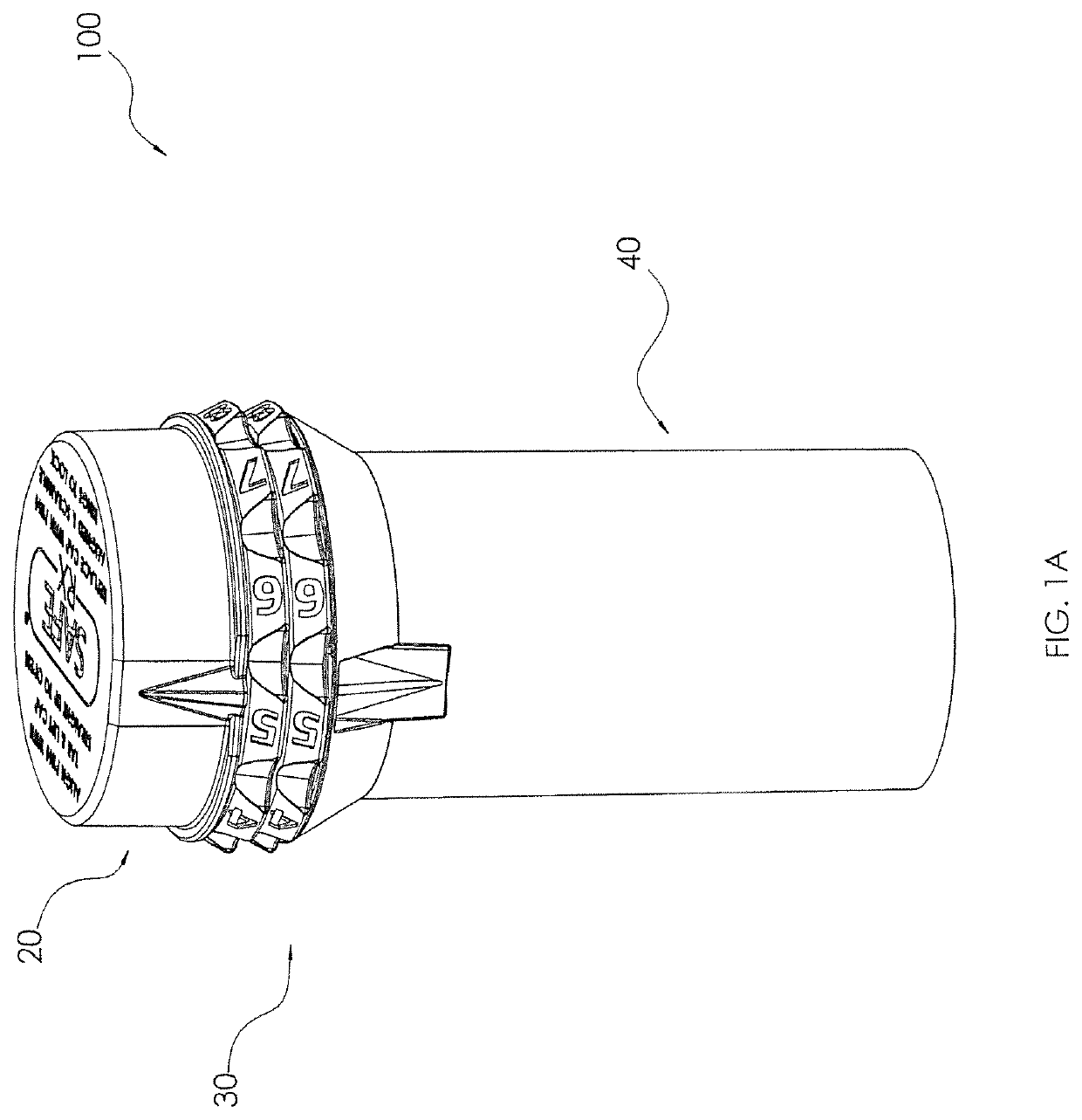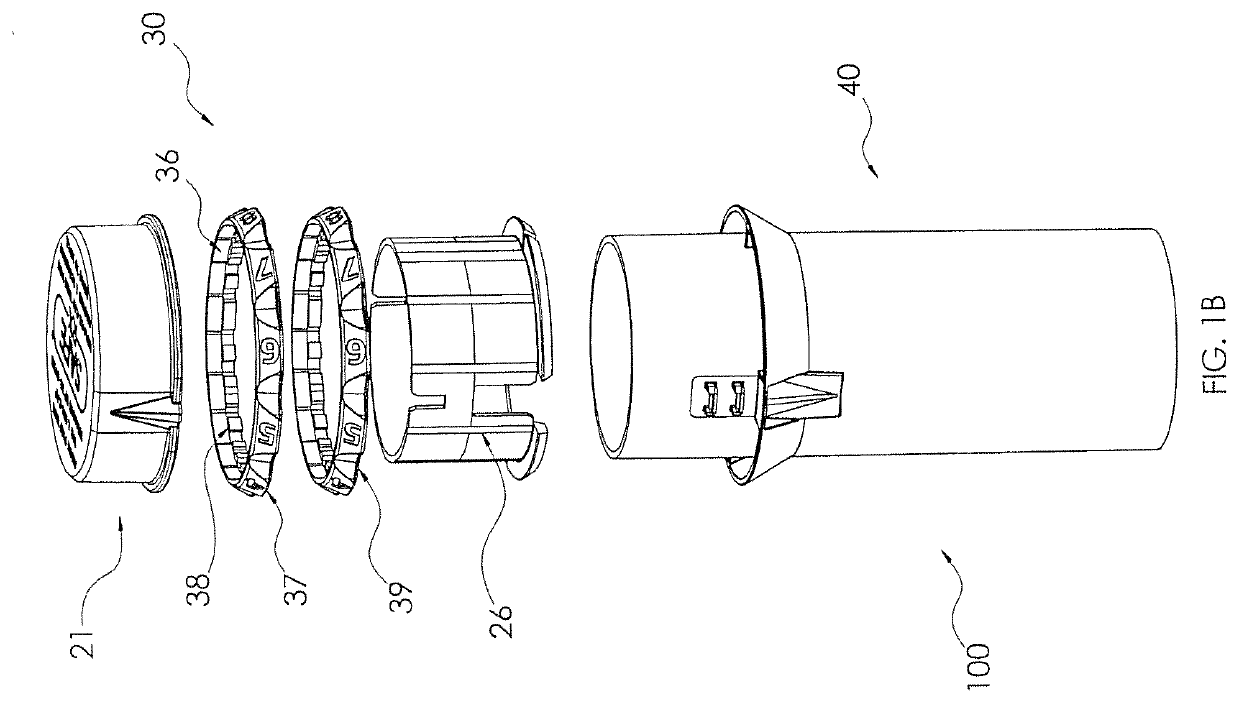Lockable container
a technology of lockable containers and containers, which is applied in the field of improved lockable containers, can solve the problems of more difficult to see alphanumerical indicia, more difficult to manipulate the less wide rings than the wider rings, and the process is more difficult to take longer, so as to eliminate the tapering of the cylindrical member
- Summary
- Abstract
- Description
- Claims
- Application Information
AI Technical Summary
Benefits of technology
Problems solved by technology
Method used
Image
Examples
second embodiment
[0065]Referring to FIG. 9, an illustrative embodiment of a second element 70 for use with a first element 50 and rotatable rings 60 in connection with a locking programmable container 100′ is shown. Although the embodied second element 70 is shown as having an annular shape, this is done for illustrative purposes only. Optionally, the second element 70 may have a belled or mushroom shape. The second element 70, which in the second embodiment may function as a cap to the canister of the container 100′ may take on any practical structural or aesthetic shape. Advantageously, the annular, belled, and mushroom shapes may serve a blocking function to prevent unauthorized personnel from observing the location where the tabs to the combination code have removed.
[0066]In some embodiments, the second element 70 may include an open first end 71, a (e.g., cylindrical) sidewall 72, and a top portion 73 that includes a completely closed second end 76. Preferably, the outer diameter of the sidewal...
third embodiment
[0070]Referring to FIGS. 10A and 10B, isometric and exploded views of a locking programmable container 100″, respectively, are shown. In some embodiments, the locking programmable container 100″ may include a first element 80, a plurality of rotatable rings 90, and a second element 110. While any number of rotatable rings 90 may be used, two rings 90 are shown in the figures and are preferred. In this variation, the rotatable rings 90 may be adapted for use on the canister portion of the container 100″.
[0071]As shown in FIG. 10B, the rotatable rings 90 may be annular, having an inner surface 91 and an outer surface 92. In some implementations, a plurality of removable tabs 93 may be formed on the inner surface 91 of each ring 90, while an alphanumeric character 94 may be located on the outer surface 92 of each ring 90. The alphanumerical characters 94 enable the consumer, pharmacist, or authorized third party to create a multi-digit (e.g., a two-digit) combination code for the purpo...
first embodiment
[0089]Alternatively, the consumer, pharmacist, authorized third party, and the like may use an encoder 200 to set the combination code for a locking container 100. Referring to FIGS. 14 and 15, an illustrative first embodiment of an encoding device or encoder 200 for programming a combination code in the rotatable rings disposed on the first element of a locking container is shown. In some embodiments, the encoder 200 may include a base portion 210 and a plunger portion 220. In some implementations, the base portion 210 of the encoder 200 may be configured to include a base element 201 (e.g., to provide support and stability) to which a post portion 202 is fixedly attached (e.g., via unitary construction). In some variations, the post portion 202 may be structured and arranged to be a hollow cylinder having a first, closed end at a proximal end thereof (e.g., at the base element 201) and a second, open end 207 at a distal end thereof. In some variations, the post portion 202 may inc...
PUM
 Login to View More
Login to View More Abstract
Description
Claims
Application Information
 Login to View More
Login to View More - R&D
- Intellectual Property
- Life Sciences
- Materials
- Tech Scout
- Unparalleled Data Quality
- Higher Quality Content
- 60% Fewer Hallucinations
Browse by: Latest US Patents, China's latest patents, Technical Efficacy Thesaurus, Application Domain, Technology Topic, Popular Technical Reports.
© 2025 PatSnap. All rights reserved.Legal|Privacy policy|Modern Slavery Act Transparency Statement|Sitemap|About US| Contact US: help@patsnap.com



